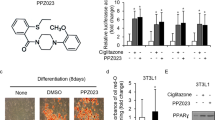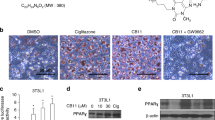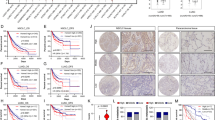Abstract
Pharmacological activators of peroxisome proliferator-activated receptor-γ (PPARγ) have been shown to inhibit growth of lung tumors largely through growth inhibition and induction of apopotosis. However, since many of these agents engage other effectors, the role of PPARγ in lung tumorigenesis remains poorly defined. To specifically examine PPARγ-mediated events, non-small-cell lung cancer (NSCLC) cells overexpressing PPARγ were established. Overexpression of PPARγ in H2122 adenocarcinoma cells (H2122-PPARγ) blocked anchorage-independent growth compared to cells transfected with empty vector (H2122-LNCX), but had no significant effect on cell proliferation or apoptosis under standard tissue culture conditions. Orthotopic implantation of H2122-PPARγ cells into the lungs of nude rats inhibited tumor growth and metastasis in vivo and prolonged survival compared to implantation of H2122-LNCX cells. Consistent with these findings, H2122-PPARγ cells had an impaired invasiveness as assessed in Transwell assays. In a three-dimensional culture system, H2122-PPARγ cells formed polarized spheroid structures similar to those observed with normal lung epithelial cells. H2122-LNCX cells formed nonpolarized aggregate structures and did not show any of these epithelial properties. These data indicate that inhibitory effects of PPARγ on lung tumorigenesis involve selective inhibition of invasive metastasis, and activation of pathways that promote a more differentiated epithelial phenotype.
This is a preview of subscription content, access via your institution
Access options
Subscribe to this journal
Receive 50 print issues and online access
$259.00 per year
only $5.18 per issue
Buy this article
- Purchase on Springer Link
- Instant access to full article PDF
Prices may be subject to local taxes which are calculated during checkout






Similar content being viewed by others
Abbreviations
- PPAR:
-
peroxisome proliferator-activated receptor
- NSCLC:
-
non-small-cell lung cancer
- TZD:
-
thiazolidindione
- PPAR-RE:
-
PPAR response element
- NSAIDs:
-
nonsteroidal anti-inflammatory drugs
- P-ERM:
-
phospho-Ezrin/Radixin/Moesin
References
Adams M, Reginato MJ, Shao D, Lazar MA and Chatterjee VK . (1997). J. Biol. Chem., 272, 5128–5132.
Akiyama TE, Sakai S, Lambert G, Nicol CJ, Matsusue K, Pimprale S, Lee Y-H, Ricote M, Glass CK, Brewer Jr HB and Gonzalez FJ . (2002). Mol. Cell. Biol., 22, 2607–2619.
Bell-Parikh LC, Ide T, Lawson JA, McNamara P, Reilly M and FitzGerald GA . (2003). J. Clin. Invest., 112, 945–955.
Berger J and Moller DE . (2002). Annu. Rev. Med., 53, 409–435.
Burstein HJ, Demetri GD, Mueller E, Sarraf P, Spiegelman BM and Winer EP . (2003). Breast Cancer Res. Treat., 79, 391–397.
Chan DC, Earle KA, Zhao TLM, Helfrich B, Zeng C, Baron A, Whitehead CM, Piazza G, Pamukcu R, Thompson WJ, Alila H, Nelson P and Bunn Jr PA . (2002). Clin. Cancer Res., 8, 904–912.
Chang T-H and Szabo E . (2000). Cancer Res., 60, 1129–1138.
Chawla A, Barak Y, Nagy L, Liao D, Tontonoz P and Evans RM . (2001). Nat. Med., 7, 48–52.
Cui Y, Miyoshi K, Claudio E, Siebenlist UK, Gonzalez FJ, Flaws J, Wagner K-U and Hennighausen L . (2002). J. Biol. Chem., 277, 17830–17835.
Debnath J, Mills KR, Collins NL, Reginato MJ, Muthuswamy SK and Brugge JS . (2002). Cell, 111, 29–40.
Debnath J, Muthuswamy SK and Brugge JS . (2003). Methods, 30, 256–268.
Demetri GD, Fletcher CD, Mueller E, Sarraf P, Naujoks R, Campbell N, Spiegelman BM and Singer S . (1999). Proc. Natl. Acad. Sci. USA, 96, 3951–3956.
Grommes C, Landreth GE and Heneka MT . (2004). Lancet Oncol., 5, 419–429.
Janda E, Lehmann K, Killisch I, Jechlinger M, Herzig M, Downward J, Beug H and Grunert S . (2002a). J. Cell. Biol., 156, 299–313.
Janda E, Litos G, Grunert S, Downward J and Beug H . (2002b). Oncogene, 21, 5148–5159.
Jiang C, Ting AT and Seed B . (1998). Nature, 391, 82–86.
Kerr KM . (2001). J. Clin. Pathol., 54, 257–271.
Keshamouni VG, Reddy RC, Arenberg DA, Joel B, Thannickal VJ, Kalemkerian GP and Standiford TJ . (2004). Oncogene, 23, 100–108.
Khanna C, Wan X, Bose S, Cassaday R, Olomu O, Mendoza A, Yeung C, Gorlick R, Hewitt SM and Helman LJ . (2004). Nat. Med., 10, 182–186.
Kinzler KW and Vogelstein B . (1996). Cell, 87, 159–170.
Kliewer SA, Lenhard JM, Willson TM, Patel I, Morris DC and Lehmann JM . (1995). Cell, 83, 813–819.
Kulke MH, Demetri GD, Sharpless NE, Ryan DP, Shivdasani R, Clark JS, Spiegelman BM, Kim H, Mayer RJ and Fuchs CS . (2002). Cancer J., 8, 395–399.
Lefebvre AM, Chen I, Desreumaux P, Najib J, Fruchart JC, Geboes K, Briggs M, Heyman R and Auwerx J . (1998). Nat. Med., 4, 1053–1057.
Lehmann JM, Lenhard JM, Oliver BB, Ringold GM and Kliewer SA . (1997). J. Biol. Chem., 272, 3406–3410.
Lehmann JM, Moore LB, Smith-Oliver TA, Wilkison WO, Willson TM and Kliewer SA . (1995). J. Biol. Chem., 270, 12953–12956.
Lynch TJ, Bell DW, Sordella R, Gurubhagavatula S, Okimoto RA, Brannigan BW, Harris PL, Haserlat SM, Supko JG, Haluska FG, Louis DN, Christiani DC, Settleman J and Haber DA . (2004). N. Engl. J. Med., 350, 2129–2139.
Malkinson AM . (1979). Toxicol. Appl. Pharmacol., 49, 551–560.
March TH, Marron-Terada PG and Belinsky SA . (2001). Vet. Pathol., 38, 483–490.
Marx N, Schonbeck U, Lazar MA, Libby P and Plutzky J . (1998). Circ. Res., 83, 1097–1103.
Mueller E, Sarraf P, Tontonoz P, Evans RM, Martin KJ, Zhang M, Fletcher C, Singer S and Spiegelman BM . (1998). Mol. Cell, 1, 465–470.
Mueller E, Smith M, Sarraf P, Kroll T, Aiyer A, Kaufman DS, Oh W, Demetri G, Figg WD, Zhou XP, Eng C, Spiegelman BM and Kantoff PW . (2000). Proc. Natl. Acad. Sci. USA, 97, 10990–10995.
Nagy L, Tontonoz P, Alvarez JG, Chen H and Evans RM . (1998). Cell, 93, 229–240.
Paez JG, Janne PA, Lee JC, Tracy S, Greulich H, Gabriel S, Herman P, Kaye FJ, Lindeman N, Boggon TJ, Naoki K, Sasaki H, Fujii Y, Eck MJ, Sellers WR, Johnson BE and Meyerson M . (2004). Science, 304, 1497–1500.
Roberts PE, Phillips DM and Mather JP . (1990). Am. J. Physiol., 259, L415–L425.
Rossi A, Kapahi P, Natoli G, Takahashi T, Chen Y, Karin M and Santoro MG . (2000). Nature, 403, 103–108.
Saez E, Tontonoz P, Nelson MC, Alvarez JG, Ming UT, Baird SM, Thomazy VA and Evans RM . (1998). Nat. Med., 4, 1058–1061.
Sarraf P, Mueller E, Jones D, King FJ, DeAngelo DJ, Partridge JB, Holden SA, Chen LB, Singer S, Fletcher C and Spiegelman BM . (1998). Nat. Med., 4, 1046–1052.
Sarraf P, Mueller E, Smith WM, Wright HM, Kum JB, Aaltonen LA, de la Chapelle A, Spiegelman BM and Eng C . (1999). Mol. Cell, 3, 799–804.
Sasaki H, Tanahashi M, Yukiue H, Moiriyama S, Kobayashi Y, Nakashima Y, Kaji M, Kiriyama M, Fukai I, Yamakawa Y and Fujii Y . (2002). Lung Cancer, 36, 71–76.
Straus DS, Pascual G, Li M, Welch JS, Ricote M, Hsiang CH, Sengchanthalangsy LL, Ghosh G and Glass CK . (2000). Proc. Natl. Acad. Sci. USA, 97, 4844–4849.
Subbaramaiah K, Lin DT, Hart JC and Dannenberg AJ . (2001). J. Biol. Chem., 276, 12440–12448.
Takai Y, Sasaki T and Matozaki T . (2001). Physiol. Rev., 81, 153–208.
Theocharis S, Kanelli H, Politi E, Margeli A, Karkandaris C, Philippides T and Koutselinis A . (2002). Lung Cancer, 36, 249–255.
Tontonoz P, Graves RA, Budavari AI, Erdjument-Bromage H, Lui M, Hu E, Tempst P and Spiegelman BM . (1994). Nucleic Acids Res., 22, 5628–5634.
Tsubouchi Y, Sano H, Kawahito Y, Mukai S, Yamada T, Kohno M, Inoue K, Hla T and Kondo M . (2000). Biochem. Biophys. Res. Comm., 270, 400–405.
Whitehead CM, Earle KA, Fetter J, Xu S, Hartman T, Chan DC, Zhao TLM, Piazza G, Klein-Szanto AJP, Pamukcu R, Alila H, Bunn Jr PA and Thompson WJ . (2003). Mol. Cancer Ther., 2, 479–488.
Wick M, Hurteau G, Dessev C, Chan D, Geraci MW, Winn RA, Heasley LE and Nemenoff RA . (2002). Mol. Pharmacol., 62, 1207–1214.
Yu Y, Khan J, Khanna C, Helman L, Meltzer PS and Merlino G . (2004). Nat. Med., 10, 175–181.
Yuan BZ, Jefferson AM, Baldwin KT, Thorgeirsson SS, Popescu NC and Reynolds SH . (2004). Oncogene, 23, 1405–1411.
Acknowledgements
This work was supported by grants from the National Institutes of Health (CA103618, CA108610, and CA58187). We thank Drs Lynn Heasley and Peter L Jones for helpful discussion. We also thank Dr Nicholas Barry for his assistance with confocal microscopy.
Author information
Authors and Affiliations
Corresponding author
Rights and permissions
About this article
Cite this article
Bren-Mattison, Y., Van Putten, V., Chan, D. et al. Peroxisome proliferator-activated receptor-γ (PPARγ) inhibits tumorigenesis by reversing the undifferentiated phenotype of metastatic non-small-cell lung cancer cells (NSCLC). Oncogene 24, 1412–1422 (2005). https://doi.org/10.1038/sj.onc.1208333
Received:
Revised:
Accepted:
Published:
Issue Date:
DOI: https://doi.org/10.1038/sj.onc.1208333
Keywords
This article is cited by
-
The influence of conjugated linoleic acid on the expression of peroxisome proliferator-activated receptor-γ and selected apoptotic genes in non-small cell lung cancer
Molecular and Cellular Biochemistry (2020)
-
Platelet-targeted pharmacologic treatments as anti-cancer therapy
Cancer and Metastasis Reviews (2017)
-
TGFβ can stimulate the p38/β-catenin/PPARγ signaling pathway to promote the EMT, invasion and migration of non-small cell lung cancer (H460 cells)
Clinical & Experimental Metastasis (2014)
-
The developing story of Sprouty and cancer
Cancer and Metastasis Reviews (2014)
-
Src-mediated morphology transition of lung cancer cells in three-dimensional organotypic culture
Cancer Cell International (2013)



